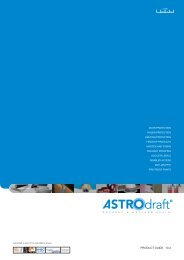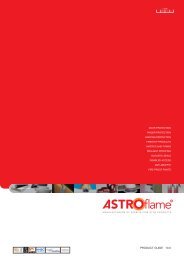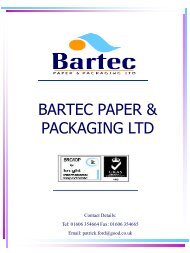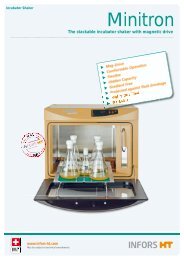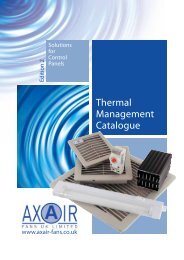Fastening & Assembly Solutions & Technology July 2012
Fastening & Assembly Solutions & Technology July 2012
Fastening & Assembly Solutions & Technology July 2012
Create successful ePaper yourself
Turn your PDF publications into a flip-book with our unique Google optimized e-Paper software.
Choosing the best method for assembling medical devices can be an exacting design task<br />
efficiency as well as quality and improvement<br />
in overall product performance.<br />
Adhesives are good gap fillers and<br />
have the ability to form an hermetic seal<br />
between two substrates and create even<br />
stress distribution. Furthermore, when the<br />
total cost of a finished medical device is<br />
considered, adhesives are frequently the<br />
most economical assembly choice.<br />
<strong>Technology</strong> leader, Henkel, has a wide<br />
range of speciality adhesives available for<br />
bonding and sealing disposable devices.<br />
These are sold under the Loctite brand.<br />
The majority are dispensed in liquid form<br />
and are converted to a solid state through<br />
the curing process that can be instigated<br />
by heat, moisture, light, surface initiation<br />
or the mixing of reactive components.<br />
What often sets Henkel apart from its<br />
competitors however is the added-value it<br />
provides, a complete solution from providing<br />
expert advice on joint design,<br />
through development trials and into automated<br />
production. Stand-alone manual,<br />
semi-automatic and automatic dispensing<br />
equipment is available off-the-shelf or for<br />
integration into high-speed production<br />
systems. Henkel also regularly undertakes<br />
the design of bespoke automated systems.<br />
No single adhesive will satisfy all<br />
needs. Designers and engineers must balance<br />
a variety of adhesive properties to<br />
obtain the required bond strength and provide<br />
an appropriate seal. In addition to the<br />
adhesives physical properties, quality and<br />
consistency, product toxicity and sterilisation<br />
durability must be factored in.<br />
The Loctite medical adhesive range<br />
falls into three basic categories: light cure<br />
acrylics, cyanoacrylates – some of which<br />
can also be UV cured - and finally<br />
epoxies.<br />
Cured by UV or visible light, this<br />
range is typically chosen for the assembly<br />
of transparent materials. The adhesives<br />
are supplied as one part, solvent-free liquids<br />
or gels. So there is no need to measure<br />
or mix and they offer a long pot life.<br />
Cure times are typically from 2 to 60 seconds<br />
and cure depths in excess of 13mm<br />
are possible. Flexible to rigid formulations<br />
are available in a wide range of viscosities<br />
and as they cure on demand, parts<br />
alignment is easy and effective. High<br />
structural strength is assured.<br />
Superglues<br />
These one-part, room temperature<br />
curing adhesives,<br />
also known as cyanoacrylates,<br />
are available with<br />
viscosities from water-thin<br />
liquids to thixotropic gels.<br />
Superglues offer excellent<br />
adhesion to most substrates,<br />
making them particularly<br />
suitable for challenging<br />
applications. They<br />
are ideal for joining flexible<br />
and rigid plastic, latex,<br />
rubber and metal substrates<br />
to themselves or<br />
each other.<br />
An important benefit of<br />
cyanoacrylates is that,<br />
when used in conjunction with a prime,<br />
they will bond to the lower surface energy<br />
plastics such as polyethylene that is<br />
commonly used in medical device manufacture.<br />
Five main types of cyanoacrylates are<br />
available for sterile medical device<br />
assembly: general purpose for bonding<br />
dissimilar materials in any combination;<br />
surface insensitive for porous, acidic or<br />
mildly contaminated substrates; thermal<br />
cycling that are able to withstand<br />
temperatures up to 120ºC and alkoxy<br />
FAST JULY <strong>2012</strong><br />
ethyls for low odour and low blooming<br />
characteristics.<br />
In recent years a UV curable grade has<br />
also extended the choice. Instead of<br />
applying an activator the part can be<br />
exposed briefly to a UV to cure the seal.<br />
It’s an ideal solution for automated production,<br />
says Henkel Loctite.<br />
Epoxies<br />
Epoxies are extensively sold into industry<br />
for a wide variety of applications and are<br />
typically two-part products that require<br />
accurate mixing of the resin and hardener.<br />
Single part epoxies are also available<br />
where the resin and hardener are premixed<br />
but these usually require refrigerated<br />
storage and a heat cure. Epoxies are<br />
extremely versatile due to the large number<br />
of combinations of epoxy resins and<br />
hardeners that are available, each of<br />
which can give a different cured polymer.<br />
A number of grades are available<br />
(approved to ISO 10993) for the medical<br />
industry and these usually have excellent<br />
Materials with the best<br />
engineering properties for<br />
sterile medical applications are<br />
often the most difficult to join<br />
adhesion to metals and some plastics but<br />
will be out performed on non polar plastics<br />
by the cyanoacrylate/primer adhesive<br />
systems. They have good temperature<br />
resistance and are often specified where<br />
parts will be subjected to repeated autoclaving<br />
cycles. The advances include high<br />
bond strengths and excellent durability<br />
but are relatively slow curing compared to<br />
cyanoacrylates and UV curing acrylics.<br />
For a complete guide to Loctite products for<br />
medical device assembly visit: www.loctite.com<br />
HENKEL LOCTITE ADHESIVES 01442 278000<br />
31



